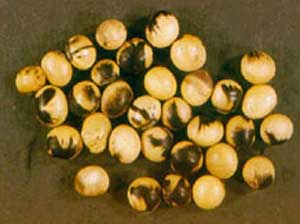
The mosaic pattern in these soybean leaves is due to infection by Bean pod mottle virus. Photo credit: Palle Pederson, Iowa State University.
Bean pod mottle virus (BPMV) is a virus disease spread primarily by the bean leaf beetle, Cerotoma trifurcata. Seed transmission is also considered a major source of BPMV; transmission from seed to seedling is about 1%. The bean leaf beetle obtains the virus from infected seedlings, or from showy tick trefoil outside of soybean fields, and spreads the virus from plant to plant as it feeds.
Agronomic impact of BPMV
- Reduced grain yield
- Reduced grain quality: protein and oil
- Poor seed appearance (mottled, moldy)
- Reduced seed performance: germination and seedling vigor
- Possible predisposition to other stresses
- Delayed plant maturation
The impact of BPMV on yield depends upon the time of virus infection. Early infection results in the highest yield reduction. Over a broad geographic range, yield reductions between 10% and 40% have been reported.
Soybeans can be infected with more than one virus at the same time. A synergistic reaction occurs when plants are infected with both BPMV and Soybean mosaic virus. Reduction in yield is much greater in mixed infections than either virus alone.
To determine if a virus problem exists in your field, look for the following signs:
- Moderate to high insect activity
- Lower than expected yields
- Mottled seed
- Delayed maturity
- Presence of leaf symptoms: mottled, crinkled leaf symptoms typical of virus infection. However, be aware that leaf symptoms are not a consistent indicator of virus infection. Varieties differ in the amount of leaf symptoms, and climate and growth stage can mask leaf symptoms. Mottled and crinkled leaves can also be caused by herbicide injury or nutrient deficiencies.
Management strategies for Bean Pod Mottle virus
- Consider a later planting of soybean next season, especially if BPMV was a yield limiting factor in this season. However, consider that late planting can result in an increased risk of soybean aphid activity at a sensitive growth stage.
- Plant soybean varieties with ability to yield in the presence of BPMV.
- Use good quality seed that is not mottled.
- Consider the field history of this problem before making decisions whether to spray for the bean leaf beetle. Sprays must be carefully timed to be effective.
Variety resistance to Bean Pod Mottle virus

Varieties differ in the rate of BPMV infection. For example, Spansoy 201 had less incidence of BPMV throughout a study conducted in the 2002 growing season when compared to Spansoy 250.
Complete resistance is not yet available, but partial resistance to BPMV exists in soybean varieties. Partial resistance is expressed as acceptable yield, low seed mottling and a low incidence of green stem in the presence of BPMV. We have observed that soybean varieties differ in yield and incidence of mottled soybean seed in the presence of BPMV. Another sign of virus tolerance is if a variety has had significant bean leaf beetle feeding yet few, if any, virus symptoms.
We have noted that varieties differ in the rate of BPMV infection. A lower incidence can translate into slower disease progression, thus a higher yield at the end of the season. One aspect of our virus screening is to identify those varieties with a lower incidence that would slow virus spread.
Using insecticides for virus control
Early soybean planting can coincide with high populations of overwintered bean leaf beetle adults moving into soybeans to feed and lay eggs. This timing increases the chance of BPMV transmission to soybeans. Concentrate initial scouting activities in early-planted fields.

Insecticide Timing Options for Bean Leaf Beetle and BPMV control. Data from Witkowski and Echtenkamp, 1996
Treatment thresholds for bean leaf beetle aimed at the prevention of bean pod mottle virus are not yet available. However, here are some guidelines:
- Were yields this year lower than expected and unexplainable? Were virus symptoms (leaf mottling, discolored seed, delayed maturity) present this year? If so, then BPMV is likely a concern for the next crop.
- Synthetic pyrethroid insecticides tend to provide the most consistent bean leaf beetle control.
- To prevent transmission of BPMV, an insecticide application must be made in the very early stages (V-V2) of soybean development.
- A second application may be necessary during the emergence of first generation beetles (late June or early July).
- Delayed spraying at either crop stage can seriously increase incidence of BPMV.
Researchers at Iowa State University have constructed a flowchart to help growers with insect/virus management decisions. View the chart in the article Revisiting an integrated approach to bean leaf beetle and bean pod mottle virus management ( Integrated Crop Management newsletter archive, May 2007)

Mottled soybean seed can be a symptom of virus-infected plants. However, not all seed mottle is caused by viruses.
Seed Mottle
Seed mottling results from pigments diffusing from the hilum. It can be a symptom associated with virus-infected plants, including BPMV and SMV. Some seed are entirely black or brown, but bicolored seed are by far more common. Hilum color will determine the color and intensity of seed coat discoloration.
Mottled seeds are an issue for grain grading, especially for food grade soybeans. Mottling is associated with poor germination and yield. All mottled seed is not caused by virus, however. Insect feeding and physiological stresses can also cause seed mottle.
Resources
Revisiting an integrated approach to bean leaf beetle and bean pod mottle virus management ( Integrated Crop Management newsletter archive 2007, but still current) – includes a flowchart to help growers with insect/virus management decisions.


